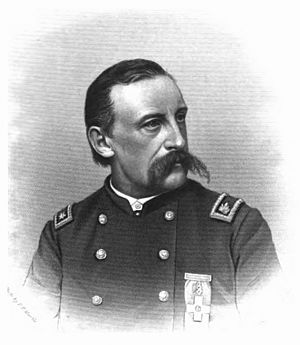Augustus Wade Dwight facts for kids
Quick facts for kids
Augustus Wade Dwight
|
|
|---|---|
 |
|
| Born | February 27, 1827 Halifax, Vermont |
| Died | March 26, 1865 (aged 38) Petersburg, Virginia |
| Buried |
Oakwood Cemetery
|
| Allegiance | United States of America Union |
| Service/ |
Infantry |
| Years of service | 1862–1865 |
| Rank | Colonel (acting) |
| Commands held | 122nd New York |
| Battles/wars | American Civil War |
Augustus Wade Dwight (born February 22, 1827 – died March 26, 1865) was a lawyer who became a brave officer in the American Civil War. He fought in 21 battles and was hurt three times. His last injury was very serious and led to his death.
Contents
Early Life
Augustus Wade Dwight was born on February 22, 1827. He was the oldest of nine children. His family lived in Halifax, Vermont. His father, Morris Dwight, was a doctor.
When Augustus was young, his family moved several times. They lived in Massachusetts and then in different towns in New York. In 1851, Augustus started college at Yale University. However, he had to leave because he couldn't afford it.
After leaving Yale, he traveled to California to join the California Gold Rush. He also studied law there for a while. He even traveled to the Hawaiian Islands and then to China. When he returned to the United States, he had traveled all the way around the world! In 1859, he became a lawyer in Onondaga County, New York.
Joining the War
About a year after the American Civil War began, more soldiers were needed. Augustus Dwight decided to join the Union Army. He planned to serve for three years.
On July 8, 1862, he became a Captain. He was in charge of Company E of the 122nd New York Volunteer Infantry Regiment. By August 28, 1862, he was promoted to lieutenant colonel. He was sent right into battle with the Army of the Potomac.
First Battles and Leadership
His regiment's first fight was the Battle of Antietam. They were held back and didn't lose any soldiers. After a few smaller fights, they saw heavy action at the Battle of Gettysburg in July 1863. Many soldiers in his group also got sick.
When Colonel Titus, the regiment's main leader, was ill, Dwight often took charge. Sometimes, both officers were unable to lead. Dwight often sent reports to the Syracuse Journal newspaper. He also wrote letters to tell families if their loved ones were killed in battle.
Wounds and Return to Duty
On September 19, 1864, at the Battle of Opequon, he was wounded for the first time. He got a bad bruise on his right leg. Even so, he kept doing his job.
On October 19, 1864, he was more seriously hurt at the Battle of Cedar Creek. A bullet badly broke his right wrist. He was given a medical discharge and sent home to recover. His right arm couldn't be used anymore.
Even with his injury, Dwight left home again on January 30, 1865. He wanted to rejoin his regiment, which was fighting at the Siege of Petersburg. On February 28, 1865, he officially took over as the acting colonel, leading his regiment.
Final Battle and Legacy
In the early morning of March 25, 1865, Confederate soldiers made a surprise attack on Fort Stedman. The Union fort was captured at first, but then it was taken back. Later that day, Dwight's regiment was ordered to attack some weakened enemy trenches. During this operation, he was hit in the head by an artillery shell. He died right away.
He was supposed to become a full colonel, but he died before it was official. Augustus Wade Dwight was buried in Oakwood Cemetery in Syracuse, New York.
In 1888, a monument was built for his regiment at the Gettysburg Battlefield. During the dedication speeches, people praised Dwight. They said he was the one "who helped make the regiment so effective and strong."

